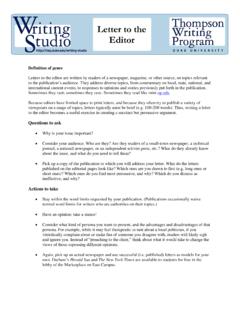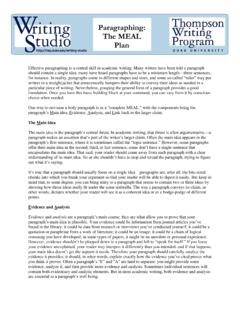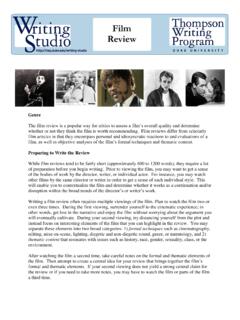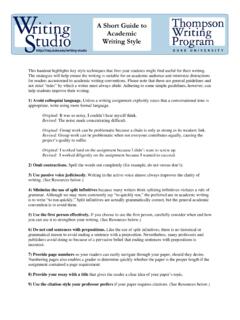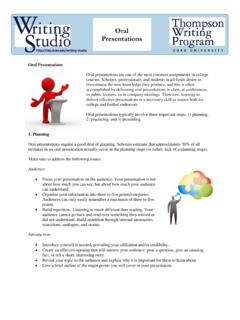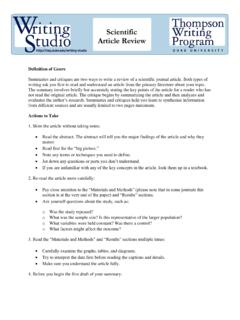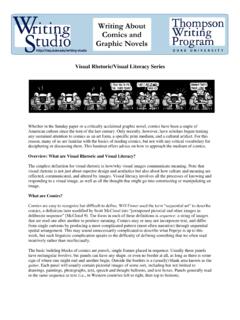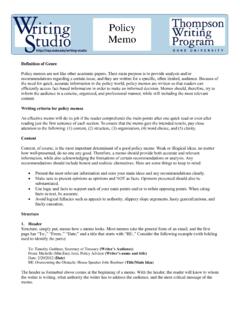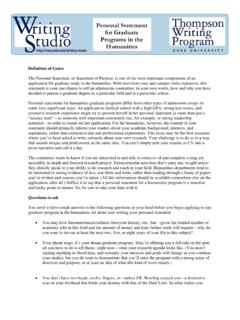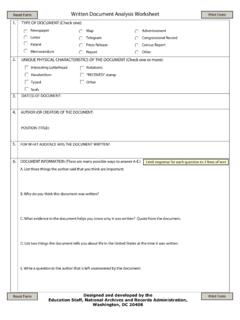Transcription of visual analysis - Duke University
1 visual analysis Definition of genre visual analysis is the basic unit of art historical writing. Sources as varied as art magazines, scholarly books, and undergraduate research papers rely on concise and detailed visual analyses. You may encounter a visual analysis as an assignment itself; or you may write one as part of a longer research paper. The purpose of a visual analysis is to recognize and understand the visual choices the artist made in creating the artwork. By observing and writing about separate parts of the art object, you will come to a better understanding of the art object as a whole. A visual analysis addresses an artwork s formal elements visual attributes such as color, line, texture, and size. A visual analysis may also include historical context or interpretations of meaning.
2 Be sure to read the assignment carefully to decide which elements of visual analysis your professor expects you to include. Some professors will look for a formal analysis alone; others will expect you to frame your formal description in terms of historical information. You may be asked to offer one or more interpretations of the possible meanings of the work. If necessary, ask your professor or to clarify expectations for the assignment. Actions to Take To write a visual analysis , you must look closely at an art object or at a photograph of an art object and translate your visual observations into written text. However, a visual analysis does not simply record your observations. It also makes a claim about the work of art. Observe the artwork and write down your observations.
3 Be precise. Consider the composition, colors, textures, size, space, and other visual and material attributes of the artwork. Go beyond your first impressions. This should take some time allow your eye to absorb the image. Making a sketch of the work can help you understand its visual logic. Formulate a main claim. Your claim might do one of the following: o Reflect on the overall organization of the work of art, Paul C zanne s Mont Sainte-Victoire [Figure 1] is composed of a number of repeated shapes and lines that serve to unify the composition. 1 1 Henry M. Sayre, Writing about Art (Upper Saddle River, NJ: Prentice Hall, 2005) 58. Figure 1: Paul C zanne, Mont Sainte-Victoire (1885-7) Duke Writing Studio 2 o Consider how formal elements impact the meaning of the artwork, Rembrandt s use of chiaroscuro heightens the sense of drama in The Night Watch [Figure 2].
4 O Relate this work relates to other works you have studied, considering how is it similar to and different from these objects, This Egyptian sculpture combines a highly conventional symmetrical style with mild asymmetry and a degree of realism [Figure 3]. 2 Support your main claim with visual details. o Analyze the form of the artwork: line, color, shape, texture, and material are good places to start. o Target your description. Address only those elements relevant to your main claim. o Organize your observations in a logical order. You might, for example, follow a line through the painting, moving from the background to the foreground, or from left to right. Consider beginning with composition and moving to material, or vice versa.
5 Many approaches are possible; choose a structure that makes sense for your main claim. In the following example, the author introduces the subject of the painting and then describes the figure s posture, gestures, and clothing: Elongated and spectral, the figure of an older man is seated at a table, painted red. He leans far to the left. His narrow head is propped upon a skeletal fist; his other hand lies, its fingers slightly spread, open on the table s edge. He is wearing a cream-colored cap and a dark blue jacket [Figure 4]. 3 2 Sylvan Barnet, A Short Guide to Writing about Art (New York: Longman, 1997) 79. 3 Cynthia Saltzman, Portrait of Dr. Gachet: The Story of a van Gogh Masterpiece.
6 Money, Politics, Collectors, Greed, and Loss (New York: Penguin, 1998), xv. Figure 2: Rembrandt, The Company of Frans Banning Cocq and Willem van Ruytenburch (The Night Watch) (1642) Figure 3: Ka-aper (c 2500-2400 BCE) Duke Writing Studio 3 o Explain why you have chosen to discuss these specific elements. In other words, explain the significance of your choices for your main claim. You may decide to incorporate a quotation from the artist to support your descriptive choices. For example: In the corner of the painting, the barely perceptible outline of a woman can be seen against a latticed background. The vagueness of her presence is necessary, as Bonnard noted in one of his notebooks, because: A figure should be part of the background against which it is placed [Figure 5].
7 4 o Discuss the relationship among visual elements of the art work: The admirable calligraphy of the text sharply contrasts the paucity of craftsmanship of the sculpture [Figure 6]. 5 Use vocabulary words mentioned in class. Foreshortening, linear perspective, and cross-hatching are some examples. Be sure to incorporate only those terms appropriate to your object. If your assignment asks you to identify the style or movement associated with the artwork, you can explore this connection by comparing the artwork s formal elements to the stylistic characteristics that you have learned in class. For example: Robert Adam s library at Kenwood is quite classical, not just because of the Corinthian columns and barrel vaults, but also because it is symmetrical, geometric, and carefully balanced [Figure 7].
8 6 You may be asked to situate your art object in its historical context. Ask yourself what the viewer needs to know about the time period in order to understand this artwork. o This may include biographical data about the artist, information about how the artwork was received in its time, or important framing of the social, political, or economic contexts of the time. o As in your formal analysis , choose evidence that supports your main claim. Helpful Links Writing in the Disciplines: Art History: Overview: visual Rhetoric / visual Literacy: 4 Laure de Buzon-Vallet and Claude Laugier, in Sasha Newman, ed., Bonnard: The Late Paintings (Paris: Centre Georges Pompidou, 1984) 198.
9 5 Denise Schmandt-Besserat, When Writing Met Art: from Symbol to Story (Austin: University of Texas Press, 2007) 95. 6 Penelope Davies, et. al., Jansen s History of Art: The Western Tradition (Upper Saddle River, NJ: Prentice Hall, 2007). Figure 4: Vincent van Gogh, Dr. Gachet (1890) Figure 5: Pierre Bonnard, Dining Room overlooking the Garden (1930-1) Duke Writing Studio 4 visual Rhetoric/ visual Literacy: Writing about Paintings visual Rhetoric/ visual Literacy: Writing about Photographs Helpful Books Suzanne Hudson and Nancy Noonan-Morrissey, The Art of Writing about Art (Belmont, CA: Thomson Learning, 2002). Henry M. Sayre, Writing about Art (Upper Saddle River, NJ: Prentice Hall, 2005). Amy Tucker, visual Literacy: Writing about Art (New York: McGraw-Hill, 2001).
10 Figure 6: The Code of Hammurabi (c. 1792-1750 BCE) Figure 7: Robert Adam, Kenwood: Middlesex Library (1767-9)
